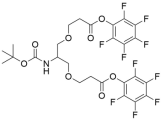Branched polyethylene glycol (PEG) pentafluorophenyl (PFP) ester is a type of PEG derivative that has gained significant attention in the field of drug research and development. It is a highly functional compound that is characterized by the presence of PEG chains and PFP ester functional groups. In this article, we will explore the classification of branched PEG PFP ester, its functional groups, and its applications in drug research and development.
The classification of it is based on the molecular weight of the PEG chains and the number of PFP ester functional groups. The PEG chains can have different molecular weights ranging from a few hundred to several thousand Daltons, while the PFP ester functional groups can be present in different numbers on each PEG chain. These variations result in different properties and applications of branched PEG PFP ester.
The functional groups present in branched PEG PFP ester are critical to its applications in drug research and development. The PEG chains in branched PEG PFP ester provide biocompatibility, water solubility, and steric hindrance properties. Meanwhile, the PFP ester functional groups provide reactive sites for conjugation with various drugs, peptides, or proteins. This allows for the controlled and targeted delivery of therapeutic agents to specific tissues or cells in the body.
the classification of it is based on its molecular weight and the number of PFP ester functional groups. This highly functional compound is widely used in drug research and development due to its biocompatibility, water solubility, and reactive sites for conjugation with various drugs, peptides, or proteins.
Branched PEG PFP ester
| Cat# | Name | Structure | Pricing |
|---|---|---|---|
| AP11784 | 2-(t-Butoxycarbonylamido)-1,3-bis(PFP-oxycarbonylethoxy)propane | Pricing |


